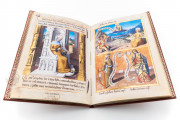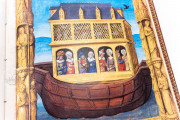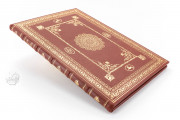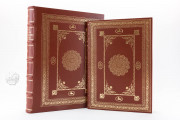The manuscript Sibylla Prophetae et de Cristo Salvatore vaticinantes (The Sibyls and Prophets Foretelling Christ the Savior), was produced in Tours in the years 1490-1500. Designed as a collection of illuminations with limited text, this Renaissance manuscript is relevant especially because of the visual parallels it draws between the sibyls and the events of the life of Christ that the sibyls had foreseen.
An elegant series of twenty-five miniatures embellish the manuscript. Jean Poyer (or Poyet) was probably responsible for the refined decorations enriched with generous use of gold.
The Complex Iconography of the Manuscript with The Sibyls and Prophets Foretelling Christ the Savior
The codex displays 25 full-page illuminations including a depiction of Noah's ark and twelve scenes from the Life of Christ organized on two registers. Each sibyl is paired with a scene from the life of Christ that she had prophesied.
An Old Testament prophet and an Evangelist accompany the illuminations featuring Christ’s life. The manuscript finds iconographic inspiration in the Book of Hours of Louis de Laval, dated 1475, and the devotional content is comparable to the Medieval moral text of Speculum Humanæ Salvationis.
Not much is known of the original history of the book. The Elector Maximilian I of Bavaria (1573–1651) acquired the manuscript and kept the book on the Sibyls and Prophets in his art collection. He considered the codex more a work of art than a book. Only in 1785, the codex was incorporated into his library.
The Role and Meanings of the Sibyls and Prophets in the Manuscript
In Ancient legends, a sibyl was an inspired woman who revealed prophecies in poetic form. The sibyls such as the Persian Sibyl, the Cimmerian Sibyl, the Delphic Sibyl, the Tiburtine Sibyl, were named after the places where their predictions were made.
They appeared in written records of the sixth century BCE and the numbers of the sibyls changed over time, stabilising at twelve during the Middle Ages. The sibylline prophecies were open to different interpretation and religions adapted the forecasts to serve their own teachings.
The small manuscript preserved in Munich presents a miniature of each sibyl with a Latin inscription and the corresponding episode from the life of Christ that the sibyl had foreseen. The manuscript reinforces the role of the sibyls as prophetic authorities from antiquity to promote the authenticity of Christian beliefs.
The codex is bound in leather with gold tooling
We have 1 facsimile edition of the manuscript "Sibylline Prophecies": Las Profecías de las Sibilas facsimile edition, published by CM Editores, 2016
Request Info / Price




















